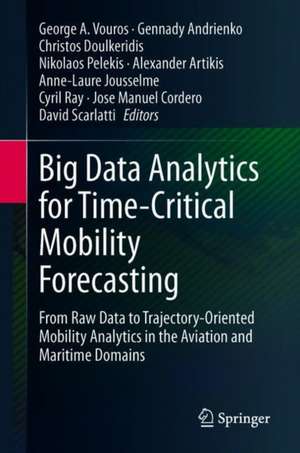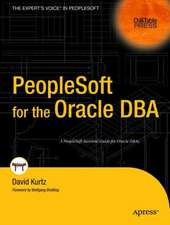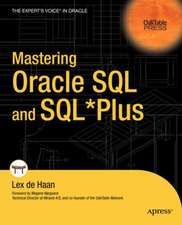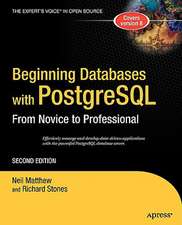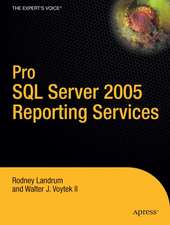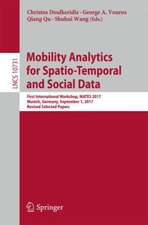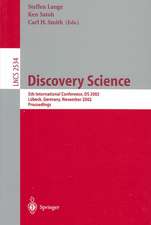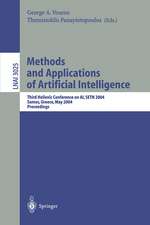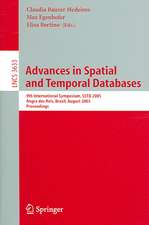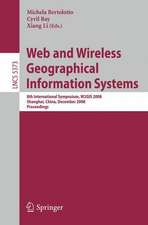Big Data Analytics for Time-Critical Mobility Forecasting: From Raw Data to Trajectory-Oriented Mobility Analytics in the Aviation and Maritime Domains
Editat de George A. Vouros, Gennady Andrienko, Christos Doulkeridis, Nikolaos Pelekis, Alexander Artikis, Anne-Laure Jousselme, Cyril Ray, Jose Manuel Cordero, David Scarlattien Limba Engleză Hardback – 24 iun 2020
The book is divided into six parts: Part I discusses the motivation and background of mobility forecasting supported by trajectory-oriented analytics, and includes specific problems and challenges in the aviation (air-traffic management) and the maritime domains. Part II focuses on big data quality assessment and processing, and presents novel technologies suitable for mobility analytics components. Next, Part III describes solutions toward processing and managing big spatio-temporal data, particularly enriching data streams and integrating streamed and archival data to provide coherent views of mobility, and storing of integrated mobility data in large distributed knowledge graphs for efficient query-answering. Part IV focuses on mobility analytics methods exploiting (online) processed, synopsized and enriched data streams as well as (offline) integrated, archived mobility data, and highlights future location and trajectory prediction methods, distinguishing between short-term and more challenging long-term predictions. Part V examines how methods addressing data management, data processing and mobility analytics are integrated in big data architectures with distinctive characteristics compared to other known big data paradigmatic architectures. Lastly, Part VI covers important ethical issues that research on mobility analytics should address.
Providing novel approaches and methodologies related to mobility detection and forecasting needs based on big data exploration, processing, storage, and analysis, this book will appeal to computer scientists and stakeholders in various application domains.
| Toate formatele și edițiile | Preț | Express |
|---|---|---|
| Paperback (1) | 1162.70 lei 6-8 săpt. | |
| Springer International Publishing – 24 iun 2021 | 1162.70 lei 6-8 săpt. | |
| Hardback (1) | 1169.13 lei 6-8 săpt. | |
| Springer International Publishing – 24 iun 2020 | 1169.13 lei 6-8 săpt. |
Preț: 1169.13 lei
Preț vechi: 1461.42 lei
-20% Nou
Puncte Express: 1754
Preț estimativ în valută:
223.74€ • 242.95$ • 187.94£
223.74€ • 242.95$ • 187.94£
Carte tipărită la comandă
Livrare economică 22 aprilie-06 mai
Preluare comenzi: 021 569.72.76
Specificații
ISBN-13: 9783030451639
ISBN-10: 3030451631
Ilustrații: XXXII, 361 p. 126 illus., 100 illus. in color.
Dimensiuni: 155 x 235 mm
Greutate: 0.73 kg
Ediția:1st ed. 2020
Editura: Springer International Publishing
Colecția Springer
Locul publicării:Cham, Switzerland
ISBN-10: 3030451631
Ilustrații: XXXII, 361 p. 126 illus., 100 illus. in color.
Dimensiuni: 155 x 235 mm
Greutate: 0.73 kg
Ediția:1st ed. 2020
Editura: Springer International Publishing
Colecția Springer
Locul publicării:Cham, Switzerland
Cuprins
Part I: Time Critical Mobility Operations and Data: A Perspective from the Maritime and Aviation Domains.- Mobility Data: A Perspective from the Maritime Domain.- The Perspective on Mobility Data from the Aviation Domain.- Part II: Visual Analytics and Trajectory Detection and Summarization: Exploring Data and Constructing Trajectories.- Visual Analytics in the Aviation and Maritime Domains.- Trajectory Detection and Summarization over Surveillance Data Streams.- Part III: Trajectory Oriented Data Management for Mobility Analytics.- Modeling Mobility Data and Constructing Large Knowledge Graphs to Support Analytics: The datAcron Ontology.- Integrating Data by Discovering Topological and Proximity Relations Among Spatiotemporal Entities.- Distributed Storage of Large Knowledge Graphs with Mobility Data.- Part IV: Analytics Towards Time Critical Mobility Forecasting.- Future Location and Trajectory Prediction.- Event Processing for Maritime Situational Awareness.- Offline Trajectory Analytics.- Part V Big Data Architectures for Time Critical Mobility Forecasting.- The δ Big Data Architecture for Mobility Analytics.- Part VI: Ethical Issues for Time Critical Mobility Analytics.- Ethical Issues in Big Data Analytics for Time Critical Mobility Forecasting.
Notă biografică
George Vouros is a Professor at the Department of Digital Systems, University of Piraeus, where he also heads the AI Lab. He has conducted extensive research in the areas of expert systems, knowledge management, knowledge representation and reasoning with ontologies, multi-agent systems and reinforcement learning. He also coordinated the datAcron Big Data project (H2020 ICT-16), on which this book is based.
Dr. Gennady Andrienko is a lead scientist responsible for visual analytics research at the Fraunhofer Institute IAIS (Sankt Augustin, Germany) and Full Professor at City University London. He has co-authored two monographs “Exploratory Analysis of Spatial and Temporal Data” (Springer, 2006) and “Visual Analytics of Movement” (Springer, 2013) and ca. 100 peer-reviewed journal papers. Gennady Andrienko received the Test of Time award at IEEE VAST 2018 and best paper awards at the AGILE 2006, IEEE VAST 2011 and 2012 conferences and EuroVA 2018 workshop.
Christos Doulkeridis is an Assistant Professor at the Department of Digital Systems at the University of Piraeus. He had been awarded both a Marie Curie fellowship and an ERCIM “Allain Bensoussan” fellowship for post-doctoral studies at the Norwegian University of Science and Technology. His research interests include big data management, parallel and distributed query processing, as well as indexing of spatial, spatio-temporal, and spatio-textual data.
Nikolaos Pelekis is an Associate Professor at the Department of Statistics and Insurance Science, University of Piraeus, Greece. His research interests include all aspects of data science, particularly mobility data management and mining. Nikos has co-authored one monograph and more than 100 refereed articles in scientific journals and conference proceedings, has received three best paper awards and won the SemEval’17 competition.
Alexander Artikis is an Assistant Professor at the University of Piraeus and a Research Associate at the National Centre for Scientific Research (NCSR) “Demokritos,” where he leads the Complex Event Recognition group. His research interests lie in the fields of artificial intelligence and distributed systems. Most of his work has been on (norm-governed) multi-agent systems and complex event recognition.
Anne‐Laure Jousselme works at the NATO Centre for Maritime Research and Experimentation in La Spezia, Italy, and serves on the Boards of Directors of the International Society of Information Fusion and the Belief Functions and Applications Society. Her research interests include maritime anomaly detection, information fusion, reasoning under uncertainty, and information quality.
Cyril Ray is an Associate Professor of Computer Science at Arts & Métiers – ParisTech, attached to the Naval Academy Research Institute (IRENav) in France. His current research focus is on the modelling and design of location-based services. His work mainly concerns theoretical aspects of the design of ubiquitous and adaptive location-based services applied to human mobility, maritime and urban transportation systems.
José Manuel Cordero is a Principal Researcher at CRIDA (ATM R&D Reference Centre, attached to the Spanish ANSP, ENAIRE) in Madrid, with extensive experience in the Air Traffic Management domain in the areas of operational performance monitoring and management, advanced computing in data analysis, and data-driven modelling. He has led a number of research projects such as SESAR Performance Management. José Manuel has co-authored more than 30 peer-reviewed papers in journals and conferences, receiving two best paper awards. He also received the Jane’ ATC Environment Award recognizing achievements in green ATM concepts. Since August 2019, he has also been appointed as a member of the EUROCONTROL Performance Review Commission.
David Scarlatti is a Data Solutions Architect at Boeing Research & Technology Europe in the Aerospace Operational Efficiency group, where he applies data analytics technologies to a wide range of aviation-related problems. His fields of expertise include big data analysis, data visualization, cyber security and human-machine interfaces.
Dr. Gennady Andrienko is a lead scientist responsible for visual analytics research at the Fraunhofer Institute IAIS (Sankt Augustin, Germany) and Full Professor at City University London. He has co-authored two monographs “Exploratory Analysis of Spatial and Temporal Data” (Springer, 2006) and “Visual Analytics of Movement” (Springer, 2013) and ca. 100 peer-reviewed journal papers. Gennady Andrienko received the Test of Time award at IEEE VAST 2018 and best paper awards at the AGILE 2006, IEEE VAST 2011 and 2012 conferences and EuroVA 2018 workshop.
Christos Doulkeridis is an Assistant Professor at the Department of Digital Systems at the University of Piraeus. He had been awarded both a Marie Curie fellowship and an ERCIM “Allain Bensoussan” fellowship for post-doctoral studies at the Norwegian University of Science and Technology. His research interests include big data management, parallel and distributed query processing, as well as indexing of spatial, spatio-temporal, and spatio-textual data.
Nikolaos Pelekis is an Associate Professor at the Department of Statistics and Insurance Science, University of Piraeus, Greece. His research interests include all aspects of data science, particularly mobility data management and mining. Nikos has co-authored one monograph and more than 100 refereed articles in scientific journals and conference proceedings, has received three best paper awards and won the SemEval’17 competition.
Alexander Artikis is an Assistant Professor at the University of Piraeus and a Research Associate at the National Centre for Scientific Research (NCSR) “Demokritos,” where he leads the Complex Event Recognition group. His research interests lie in the fields of artificial intelligence and distributed systems. Most of his work has been on (norm-governed) multi-agent systems and complex event recognition.
Anne‐Laure Jousselme works at the NATO Centre for Maritime Research and Experimentation in La Spezia, Italy, and serves on the Boards of Directors of the International Society of Information Fusion and the Belief Functions and Applications Society. Her research interests include maritime anomaly detection, information fusion, reasoning under uncertainty, and information quality.
Cyril Ray is an Associate Professor of Computer Science at Arts & Métiers – ParisTech, attached to the Naval Academy Research Institute (IRENav) in France. His current research focus is on the modelling and design of location-based services. His work mainly concerns theoretical aspects of the design of ubiquitous and adaptive location-based services applied to human mobility, maritime and urban transportation systems.
José Manuel Cordero is a Principal Researcher at CRIDA (ATM R&D Reference Centre, attached to the Spanish ANSP, ENAIRE) in Madrid, with extensive experience in the Air Traffic Management domain in the areas of operational performance monitoring and management, advanced computing in data analysis, and data-driven modelling. He has led a number of research projects such as SESAR Performance Management. José Manuel has co-authored more than 30 peer-reviewed papers in journals and conferences, receiving two best paper awards. He also received the Jane’ ATC Environment Award recognizing achievements in green ATM concepts. Since August 2019, he has also been appointed as a member of the EUROCONTROL Performance Review Commission.
David Scarlatti is a Data Solutions Architect at Boeing Research & Technology Europe in the Aerospace Operational Efficiency group, where he applies data analytics technologies to a wide range of aviation-related problems. His fields of expertise include big data analysis, data visualization, cyber security and human-machine interfaces.
Textul de pe ultima copertă
This book provides detailed descriptions of big data solutions for activity detection and forecasting of very large numbers of moving entities spread across large geographical areas. It presents state-of-the-art methods for processing, managing, detecting and predicting trajectories and important events related to moving entities, together with advanced visual analytics methods, over multiple heterogeneous, voluminous, fluctuating and noisy data streams from moving entities, correlating them with data from archived data sources expressing e.g. entities’ characteristics, geographical information, mobility patterns, mobility regulations and intentional data.
The book is divided into six parts: Part I discusses the motivation and background of mobility forecasting supported by trajectory-oriented analytics, and includes specific problems and challenges in the aviation (air-traffic management) and the maritime domains. Part II focuses on big data quality assessment and processing, and presents novel technologies suitable for mobility analytics components. Next, Part III describes solutions toward processing and managing big spatio-temporal data, particularly enriching data streams and integrating streamed and archival data to provide coherent views of mobility, and storing of integrated mobility data in large distributed knowledge graphs for efficient query-answering. Part IV focuses on mobility analytics methods exploiting (online) processed, synopsized and enriched data streams as well as (offline) integrated, archived mobility data, and highlights future location and trajectory prediction methods, distinguishing between short-term and more challenging long-term predictions. Part V examines how methods addressing data management, data processing and mobility analytics are integrated in big data architectures with distinctive characteristics compared to other known big data paradigmatic architectures. Lastly, Part VI covers important ethical issues that research on mobility analytics should address.
Providing novel approaches and methodologies related to mobility detection and forecasting needs based on big data exploration, processing, storage, and analysis, this book will appeal to computer scientists and stakeholders in various application domains.
The book is divided into six parts: Part I discusses the motivation and background of mobility forecasting supported by trajectory-oriented analytics, and includes specific problems and challenges in the aviation (air-traffic management) and the maritime domains. Part II focuses on big data quality assessment and processing, and presents novel technologies suitable for mobility analytics components. Next, Part III describes solutions toward processing and managing big spatio-temporal data, particularly enriching data streams and integrating streamed and archival data to provide coherent views of mobility, and storing of integrated mobility data in large distributed knowledge graphs for efficient query-answering. Part IV focuses on mobility analytics methods exploiting (online) processed, synopsized and enriched data streams as well as (offline) integrated, archived mobility data, and highlights future location and trajectory prediction methods, distinguishing between short-term and more challenging long-term predictions. Part V examines how methods addressing data management, data processing and mobility analytics are integrated in big data architectures with distinctive characteristics compared to other known big data paradigmatic architectures. Lastly, Part VI covers important ethical issues that research on mobility analytics should address.
Providing novel approaches and methodologies related to mobility detection and forecasting needs based on big data exploration, processing, storage, and analysis, this book will appeal to computer scientists and stakeholders in various application domains.
Caracteristici
Provides comprehensive descriptions of big data solutions for activity detection and forecasting very large numbers of moving entities spread across large geographical areas Details novel approaches and methodologies for mobility detection and forecasting, based on big data management and analysis Provides data management and mobility analytics solutions over voluminous and noisy data streams correlated with archived data
